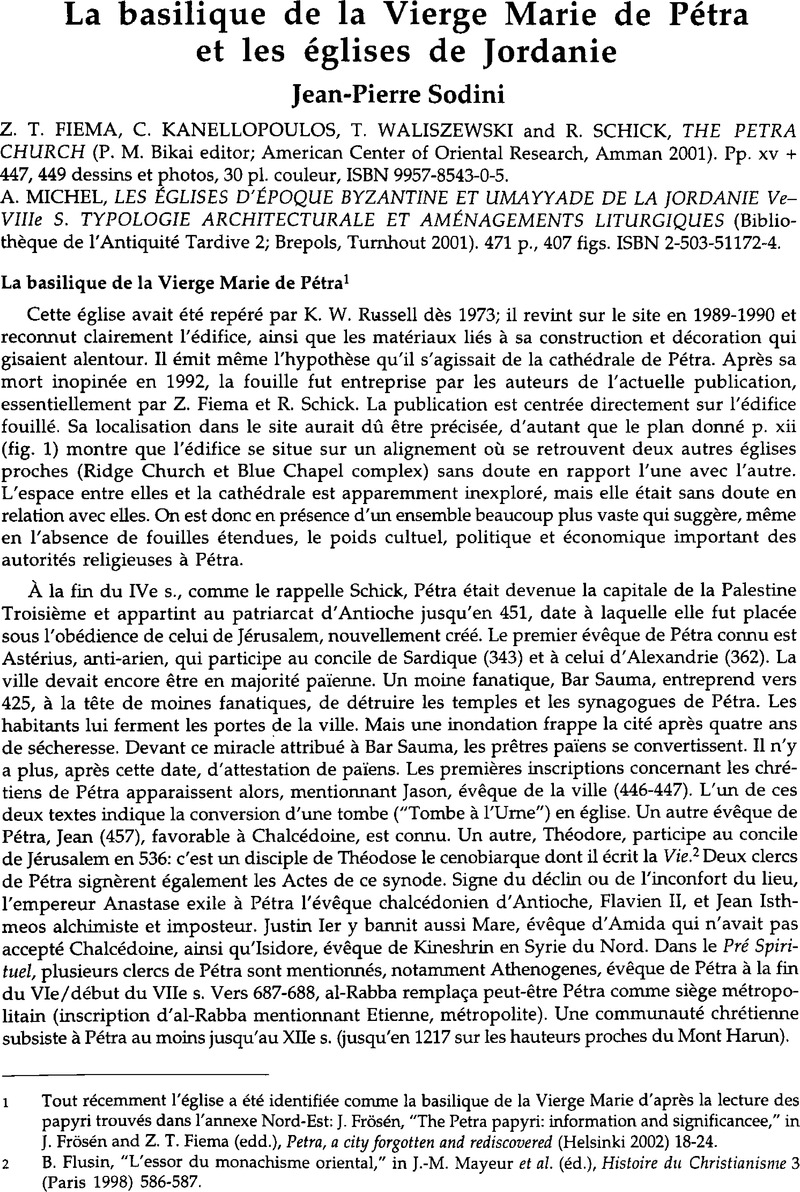No CrossRef data available.
Article contents
La basilique de la Vierge Marie de Pétra et les églises de Jordanie - Z. T. Fiema, C. Kanellopoulos, T. Waliszewski and R. Schick, THE PETRA CHURCH (P. M. Bikai editor; American Center of Oriental Research, Amman 2001). Pp. xv + 447, 449 dessins et photos, 30 pl. couleur, ISBN 9957-8543-0-5. - A. Michel, LES ÉGLISES D'ÉPOQUE BYZANTINE ET UMAYYADE DE LA JORDANIE Ve-VIIIe S. TYPOLOGIE ARCHITECTURALE ET AMÉNAGEMENTS LITURGIQUES (Bibliothèque de Antiquité Tardive 2; Brepols, Turnhout 2001). 471 p., 407 figs. ISBN 2-503-51172-4.
Published online by Cambridge University Press: 16 February 2015
Abstract

- Type
- Reviews
- Information
- Copyright
- Copyright © Journal of Roman Archaeology L.L.C. 2002
References
1 Tout récemment l'église a été identifiée comme la basilique de la Vierge Marie d'après la lecture des papyri trouvés dans l'annexe Nord-Est: Frösén, J., “The Petra papyri: information and significancee,” in Frösén, J. and Fiema, Z. T. (edd.), Petra, a city forgotten and rediscovered (Helsinki 2002) 18–24 Google Scholar.
2 Flusin, B., “L'essor du monachisme oriental”, in Mayeur, J.-M. et al. (éd.), Histoire du Christianisme 3 (Paris 1998) 586–587 Google Scholar.
3 Frösen, J., rapports de fouille annuels: ADAJ 42 (1998) 483–502 Google Scholar, ADAJ 43 (1999) 369–410 Google Scholar, ADAJ 44 (2000) 395–424 Google Scholar, ADAJ 45 (2001) 395–424 Google Scholar; Z. T. Fiema and R. Holmgren, “The Byzantine monastic/pilgrimage center of St. Aaron near Petra,” in Petra, a city forgotten (supra n.1); Z. T. Fiema, “The mosaic in the Jabal Hârun church,” ibid., 224-28.
4 Koenen, L., “The carbonized archive from Petra,” JRA 9 (1996) 177–88Google Scholar.
5 A. Michel (voir ci-après) 58-59.
6 Ajouter, outre Pella, à la liste donnée par Margalit, S., “On the transformation of the mono-apsidal churches with two lateral pastophoria into tri-apsidal churches,” LA 39 (1989) 143–164 Google Scholar, les nouveaux dégagements récemment entrepris par Goldfus, H. et al., “New excavations in the East Church at Halutza (Elusa): preliminary report,” JRA 13 (2000) 331–342 Google Scholar.
7 Variante palestinienne, mise au point à Jérusalem ou à Cesaree et diffusée dans toute cette zone: Sodini, J.-P., Barsanti, C. et Guidobaldi, A. Guiglia, “La sculpture architecturale en marbre au VIe s.,” Acta XIII Cong. Int. Arch. Christ 1994 (Città del Vaticano–Split 1998) vol. 2, 304–307 Google Scholar.
8 Dentzer-Feydy, J., “Introduction de l'acanthe dans la sculpture monumentale du Proche-Orient à l'époque gréco-romaine,” in L'acanthe dans la sculpture monumentale de l'Antiquité à la Renaissance (Paris 1993) 100–101 Google Scholar.
9 Gui, I., Duval, N. et Cailler, J.-P., Basiliques chrétiennes d'Afrique du Nord, I. Inventaire de l'Algérie (Coll. des Etudes Augustiniennes, Sér. Antiquité 129, 1992)Google Scholar.
10 Chevalier, P., Salona II, Ecclesiae Dalmatiae (CollEFR 194.2, 1996)Google Scholar.
11 ESI 17 (1998) 30, fig. 35Google ScholarPubMed.
12 Mare, W. H., “The 1996 season of excavation at Abila of the Decapolis,” ADAJ 41 (1997) 307, fig. 3: l'église, très courte, était probablement à cinq nefsGoogle Scholar.
13 Brenk, B., “Der Kultort, seine Zugänglichkeit und seine Besucher,” in Akten des XII. Int. Kongr. Christ. Arch. 1991 (Münster 1995) vol. 1, 107–109, fig. 21Google Scholar. La reconstitution du plan et sa datation ne sont pas assurées.
14 Très mal connue: Ovadiah, A. et de Silva, C. G., “Supplementum to the corpus of the Byzantine churches in the Holy Land,” Levant 13 (1981) n° 26, 223–224 CrossRefGoogle Scholar.
15 Sodini, J.-P., “La basilique de la Campanopétra à Chypre,” JRA 13 (2000) 769 Google Scholar.
16 Gelichi, S. et Negrelii, C., “La ricognizione del 1999: Laodicea in età tardoantica e bizantina,” di Frigia I (Rome 2000) 134–149 Google Scholar.
17 Madjarov, M., “Diocletianopolis, ville paléochrétienne de Thrace,” Actes da XI Cong. Int. Arch. Chrét. 1986 (Rome 1989) vol. 3, 2534, fig. 13Google Scholar; Tchaneva-Detchevska, N., “Les édifices culturels sur le territoire bulgare pendant la période paléochrétienne à la lumière des nouvelles données,” Xi CIAC 1986, vol. 3, 2504 Google Scholar; Tchaneva-Detchevska, N., L'architecture paléochrétienne de Bulgarie (IVe-VIIe s.) (Sophia 1999) 66–78 (en bulgare)Google Scholar.
18 Khrouchkova, L. G., “Pitiunt et le littoral de la Mer Noire à l'époque paléochrétienne,” Xi CIAC 1986, vol. 3, 2657–2686, notamment fig. 5, 7 et 23Google Scholar.
19 Pallas, D. I., “Scoperte archeologiche in Grecia negli anni 1956-1958,” RACrist 35 (1959) 187–223 Google Scholar, particulièrement 219-220, fig. 36: la date proposée par Pallas (VIIe–début VIIIe s.) est hypothétique.
20 Pallas, D. I., “Corinthe et Nicopolis pendant le Bas (= Haut) Moyen-Age,” Felix Ravenna 118 (1979) 129–131 et fig. 16 (avec bibliographie)Google Scholar.
21 Anamali, S., “L'état actuel des recherches sur l'origine des villes du Moyen Âge en Albanie,” XI CIAC 1986, vol. 3, 2624–2629, fig. 4Google Scholar.
22 Balderstone, S., “The context of the Pella churches in terms of architectural planning principles derived from contemporary theology and liturgy”, in Walmsley, A. (ed.), Australians uncovering ancient Jordan (Sydney 2001) 121–130 Google Scholar.
A correction has been issued for this article:
Linked content
Please note a has been issued for this article.


